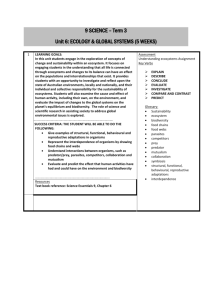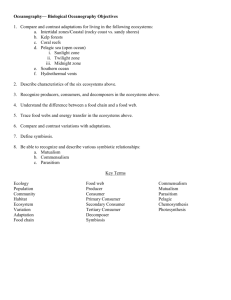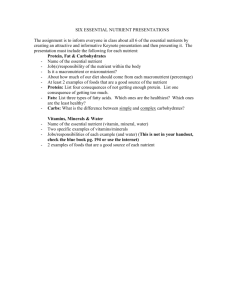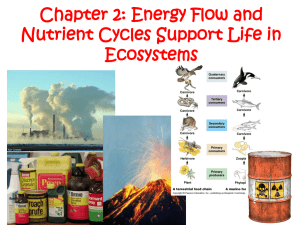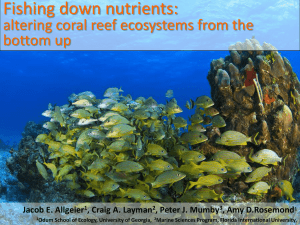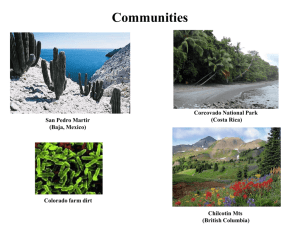Review Sheet for Final Exam, Ecology Spring 2011 (Tues. May 3, 12
advertisement
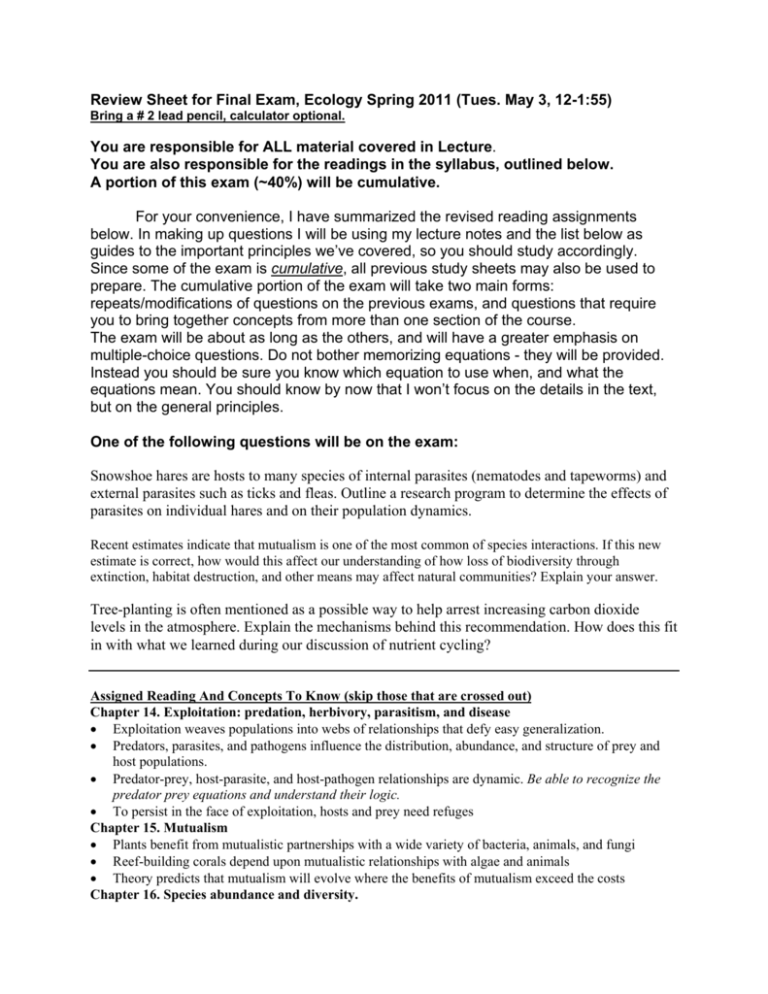
Review Sheet for Final Exam, Ecology Spring 2011 (Tues. May 3, 12-1:55) Bring a # 2 lead pencil, calculator optional. You are responsible for ALL material covered in Lecture. You are also responsible for the readings in the syllabus, outlined below. A portion of this exam (~40%) will be cumulative. For your convenience, I have summarized the revised reading assignments below. In making up questions I will be using my lecture notes and the list below as guides to the important principles we’ve covered, so you should study accordingly. Since some of the exam is cumulative, all previous study sheets may also be used to prepare. The cumulative portion of the exam will take two main forms: repeats/modifications of questions on the previous exams, and questions that require you to bring together concepts from more than one section of the course. The exam will be about as long as the others, and will have a greater emphasis on multiple-choice questions. Do not bother memorizing equations - they will be provided. Instead you should be sure you know which equation to use when, and what the equations mean. You should know by now that I won’t focus on the details in the text, but on the general principles. One of the following questions will be on the exam: Snowshoe hares are hosts to many species of internal parasites (nematodes and tapeworms) and external parasites such as ticks and fleas. Outline a research program to determine the effects of parasites on individual hares and on their population dynamics. Recent estimates indicate that mutualism is one of the most common of species interactions. If this new estimate is correct, how would this affect our understanding of how loss of biodiversity through extinction, habitat destruction, and other means may affect natural communities? Explain your answer. Tree-planting is often mentioned as a possible way to help arrest increasing carbon dioxide levels in the atmosphere. Explain the mechanisms behind this recommendation. How does this fit in with what we learned during our discussion of nutrient cycling? Assigned Reading And Concepts To Know (skip those that are crossed out) Chapter 14. Exploitation: predation, herbivory, parasitism, and disease • Exploitation weaves populations into webs of relationships that defy easy generalization. • Predators, parasites, and pathogens influence the distribution, abundance, and structure of prey and host populations. • Predator-prey, host-parasite, and host-pathogen relationships are dynamic. Be able to recognize the predator prey equations and understand their logic. • To persist in the face of exploitation, hosts and prey need refuges Chapter 15. Mutualism • Plants benefit from mutualistic partnerships with a wide variety of bacteria, animals, and fungi • Reef-building corals depend upon mutualistic relationships with algae and animals • Theory predicts that mutualism will evolve where the benefits of mutualism exceed the costs Chapter 16. Species abundance and diversity. • Most species are moderately abundant; few are very abundant or extremely rare. • A combination of the number of species and their relative abundance defines species diversity • Species diversity is higher in complex environments • Intermediate levels of disturbance promote higher diversity Chapter 17. Food Webs • A food web summarizes the feeding relations in a community • Indirect interactions between species are fundamental to communities • The feeding activities of a few keystone species may control the structure of communities • Mutualists can act as keystone species Chapter 18. Primary production and energy flow • Terrestrial primary production is generally limited by temperature and moisture • Aquatic primary production is generally limited by nutrient availability • Consumers can influence rates of primary production in aquatic and terrestrial ecosystems • Energy losses limit the number of trophic levels in ecosystems Chapter 19 Nutrient cycling and retention -- focus on the cycles as covered in lecture. • Nutrient cycles involve the storage of chemical elements in nutrient pools, or compartments, and the flux, or transfer of nutrients between pools • Decomposition rate is influenced by temperature, moisture, and chemical composition of litter and the environment • Plants and animals can modify the distribution and cycling of nutrients in ecosystems • Disturbance increases nutrient loss from ecosystems Chapter 20. Succession and stability. • Community changes during succession include increases in species diversity and changes in species composition • Ecosystem changes during succession include increases in biomass, production, respiration, and nutrient retention • Mechanisms that drive ecological succession include facilitation, tolerance, and inhibition • Community stability may be due to lack of disturbance or community resistance or resilience in the face of disturbance Chapter 22. Geographic Ecology. • On islands and habitat patches on continents, species richness increases with area and decreases with isolation • Species richness on islands can be modeled as a dynamic balance between immigration and extinction of species • Species richness generally increases from middle and high latitudes to the equator • Long-term historical and regional processes significantly influence the structure of biotas and ecosystems Chapter 23. Global Ecology - know CO2 well (as it was also covered in lecture). • The El Niño Southern Oscillation is a large-scale atmospheric and oceanic phenomenon that influences ecological systems on a global scale • Human activity has greatly increased the quantity of fixed nitrogen cycling through the biosphere • Rapid changes in global patterns of land use threaten biological diversity • Human activity is changing the composition of the atmosphere

